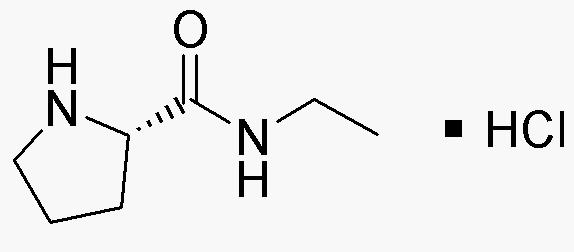L-Proline ethylamide hydrochloride is widely utilized in research focused on:
- Pharmaceutical Development: This compound serves as a building block in the synthesis of various pharmaceuticals, particularly those targeting neurological disorders, enhancing drug efficacy and specificity.
- Peptide Synthesis: It is commonly used in the production of peptides, which are crucial in drug formulation and biochemistry, offering improved stability and bioactivity compared to traditional amino acids.
- Biochemical Research: Researchers employ this compound to study protein folding and enzyme activity, providing insights into metabolic pathways and potential therapeutic targets.
- Food Industry: It can be utilized as a flavor enhancer or stabilizer in food products, improving taste profiles while maintaining safety and quality standards.
- Cosmetic Formulations: The compound is also found in skincare products, where it acts as a moisturizing agent, helping to improve skin hydration and texture.
General Information
Properties
Safety and Regulations
Applications
L-Proline ethylamide hydrochloride is widely utilized in research focused on:
- Pharmaceutical Development: This compound serves as a building block in the synthesis of various pharmaceuticals, particularly those targeting neurological disorders, enhancing drug efficacy and specificity.
- Peptide Synthesis: It is commonly used in the production of peptides, which are crucial in drug formulation and biochemistry, offering improved stability and bioactivity compared to traditional amino acids.
- Biochemical Research: Researchers employ this compound to study protein folding and enzyme activity, providing insights into metabolic pathways and potential therapeutic targets.
- Food Industry: It can be utilized as a flavor enhancer or stabilizer in food products, improving taste profiles while maintaining safety and quality standards.
- Cosmetic Formulations: The compound is also found in skincare products, where it acts as a moisturizing agent, helping to improve skin hydration and texture.
Documents
Safety Data Sheets (SDS)
The SDS provides comprehensive safety information on handling, storage, and disposal of the product.
Product Specification (PS)
The PS provides a comprehensive breakdown of the product’s properties, including chemical composition, physical state, purity, and storage requirements. It also details acceptable quality ranges and the product's intended applications.
Certificates of Analysis (COA)
Search for Certificates of Analysis (COA) by entering the products Lot Number. Lot and Batch Numbers can be found on a product’s label following the words ‘Lot’ or ‘Batch’.
*Catalog Number
*Lot Number
Certificates Of Origin (COO)
This COO confirms the country where the product was manufactured, and also details the materials and components used in it and whether it is derived from natural, synthetic, or other specific sources. This certificate may be required for customs, trade, and regulatory compliance.
*Catalog Number
*Lot Number
Safety Data Sheets (SDS)
The SDS provides comprehensive safety information on handling, storage, and disposal of the product.
DownloadProduct Specification (PS)
The PS provides a comprehensive breakdown of the product’s properties, including chemical composition, physical state, purity, and storage requirements. It also details acceptable quality ranges and the product's intended applications.
DownloadCertificates of Analysis (COA)
Search for Certificates of Analysis (COA) by entering the products Lot Number. Lot and Batch Numbers can be found on a product’s label following the words ‘Lot’ or ‘Batch’.
*Catalog Number
*Lot Number
Certificates Of Origin (COO)
This COO confirms the country where the product was manufactured, and also details the materials and components used in it and whether it is derived from natural, synthetic, or other specific sources. This certificate may be required for customs, trade, and regulatory compliance.

